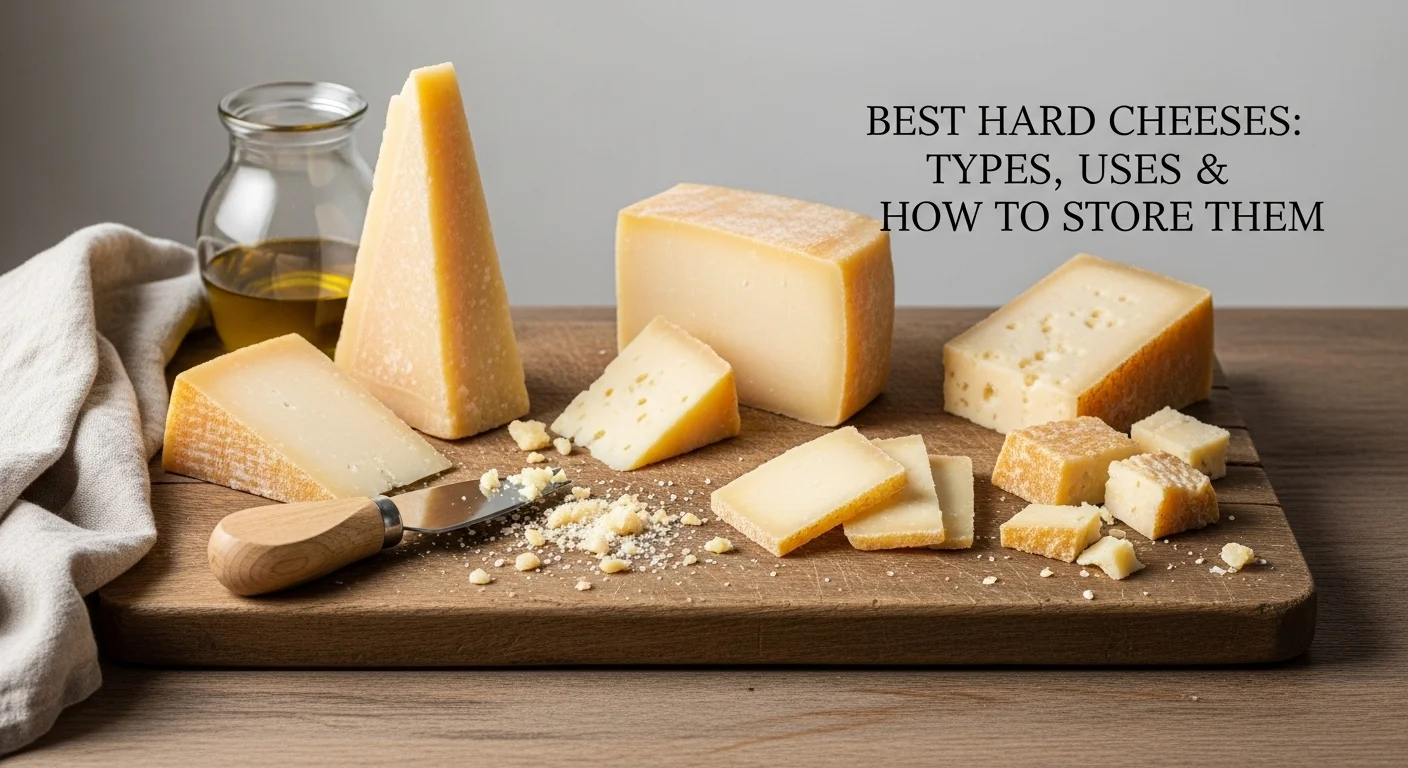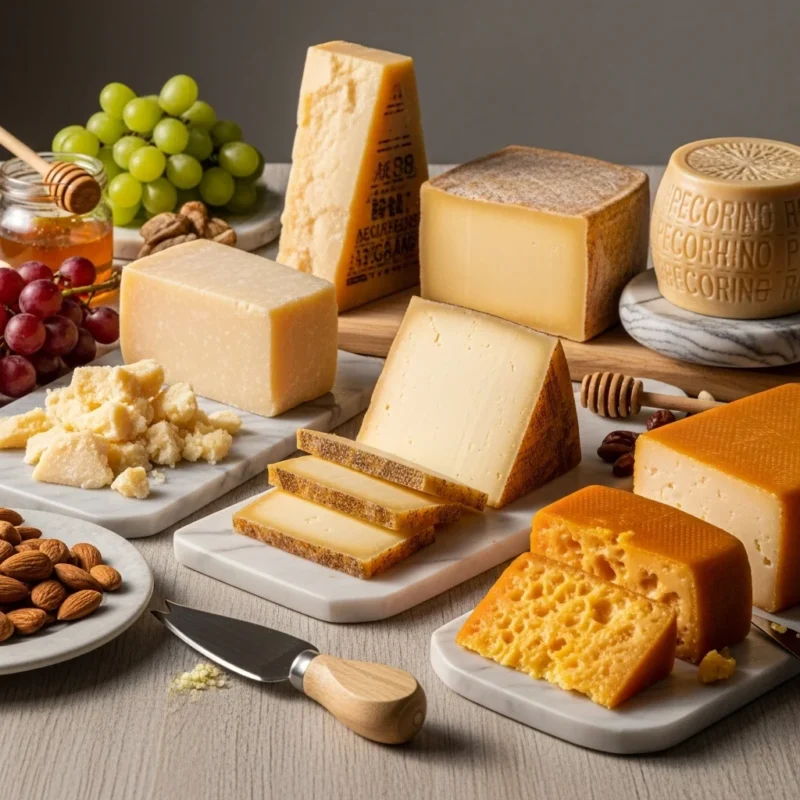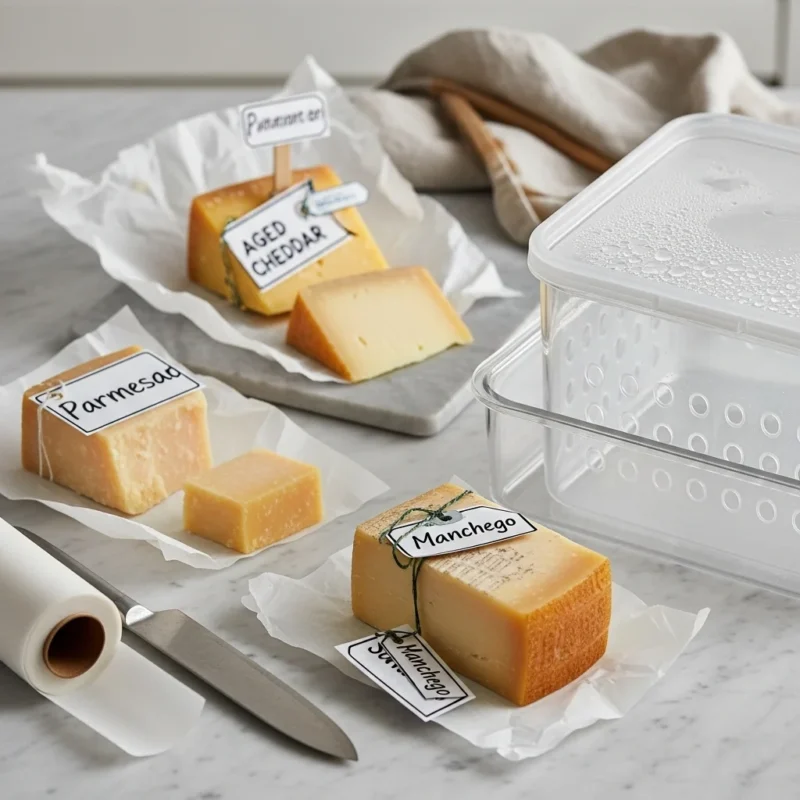Blog
Best Hard Cheeses: Types, Uses and How 2 Store Them

Ever open your fridge, stare at the cheese drawer, and wonder which block actually deserves a spot on your plate? Hard cheeses are the unsung heroes of the dairy world bold in flavor, rich in nutrition, and surprisingly long-lasting. High in protein, calcium, and healthy fats, they’re not just delicious; they’re genuinely good for you in moderation. From the sharp bite of aged cheddar to the nutty depth of Parmigiano-Reggiano, the best hard cheeses add both flavor and nourishment to your meals. In this guide on Best Hard Cheeses: Types, Uses, and How to Store Them, we’ll explore what makes these cheeses unique, how to use them creatively, and the smartest ways to keep them fresh and full of character.
What is “Hard Cheese”?
When you hear “hard cheese”, it doesn’t just mean “firm” in a casual sense. There’s a method behind the texture. According to The Cheese Geek: hard cheeses are “aged for anything between 12-36 months” and have had more whey expelled, giving them lower moisture content and stronger flavor.
The Castello site adds that hard cheese is made by draining most whey, pressing the curd and aging it (sometimes 2-36 months or longer) so the flavor and firm body develop.
Key markers of hard cheese:
- Low moisture → firm, sometimes crumbly texture
- Aged longer than fresh or soft cheeses
- More intense, nutty, savoury flavour (Umami, salt crystals in many cases)
- Good for grating or slicing as a flavour-hero, not just for melting runny
So when you pick up something labelled “aged cheddar 18 mo”, “Parmigiano-Reggiano 24 mo”, or “Manchego 12 mo”, you’re firmly in hard cheese territory.
Types of Hard Cheese and Their Uses
Let’s walk through three buckets: classic staples, offbeat gems, and ultra-aged/rare finds. For each: what you’ll recognize it by, how you use it in real lifestyle.
Classic Staples
Parmigiano-Reggiano / Parmesan
You know this one. Italian, very aged, granular texture, salt crystals, big nuttiness. From Castello: it’s listed as a key hard cheese.
Use it: Grate over pasta, risotto, soups, roasted veggies. Keep a chunk and shave thin slices for salads or cheese boards.
Why it stands out: The ageing and dryness make it flavor-packed and long-lived (more on storage later).
Aged Cheddar (12-24 mo+)
From The Cheese Geek: cheddar appears as a hard cheese when mature.
Use it: Melt it in gourmet grilled cheese, cubes with beer, strong chip dip, baked potato topping. If it’s cloth-bound cheddar (more dry, crumbly), you can eat it neat, with a robust red wine.
Why it stands out: Big flavour, often more “complex” than plain mild cheddar, good texture variety.
Manchego
Not always mentioned in every “hard cheese” guide, but it belongs: firm sheep-milk, Spanish origin.
Use it: Thin slices for tapas, pair with quince paste, or grate some over rustic potato dishes.
Why it stands out: Sheep-milk gives it different flavour profile (a hint of “barnyard” or “grass-fed” nuance) and texture that’s somewhere between firm and crumbly.
Offbeat Gems
Comté / Gruyère (aged)
From the buyer’s guide: Comté and Gouda listed among hard cheeses.
Use it: Melt in fondue, gratin, croque-monsieur. Or cube for a cheese board with honey and almonds.
Why it stands out: Rich and smooth, sometimes crystalline with age, but less “brick wall” hard than very old Parmesan.
Dutch Aged Gouda
Often aged 18-30 months, becomes caramelised, crunchy in bits, rich.
Use it: Serve thin slices with dark beer, grate onto mac & cheese for flavour boost, pair with apple or pear.
Why it stands out: Sweet + savoury combo, not as aggressively “nutty” as some others but super tasty.
Pecorino Romano
Italian sheep-milk, salty, good for grating.
Use it: Use instead of or in mix with Parmesan for pasta. Thin slices or shards in salads.
Why it stands out: Salty kick, stronger flavour, can stand up to bold sauces.
Ultra-Aged / Rare Finds
These are for the cheese lovers or for when you want to impress.
Sbrinz (Switzerland)
Listed on Wikipedia: a very hard Swiss cheese aged 24-30 months.
Use it: Shavings on herb-olive oil toasts, or grated on risotto.
Why it stands out: Extreme ageing = deep flavour, crystalline bits, rare-treat feel.
Berner Alpkäse / Berner Hobelkäse
Also Swiss, aged even more, super firm.
Use it: Thin slices with rustic bread and raw-milk mustard; grate for Alpine-style dishes.
Why it stands out: Worth buying if you find it, because it beholds a “cheese occasion” rather than everyday staple.
How to Use Hard Cheese – More Than Just Grate & Go
Hard cheese has more tricks than you might think. Here are use-cases people often miss.

In cooking
- Melt into a cream or soup for depth (aged Gruyère + Leek soup = luxury).
- Combine with breadcrumbs on top of a bake for crunch + flavour.
- Use rind (like Parm rind) to flavor soups & stews (drop rind into pot while cooking).
Bonus tip: Rinds of many hard cheeses are edible or usable. Castello says natural rinds accumulate flavor and can go into soups.
On the board / snack
Hard cheeses hold up well on a board (they don’t puddle or melt in warm rooms). Provide block + knife rather than pre-sliced, so your guests can cut what they want.
In unexpected combos
- Cube aged cheddar with dark chocolate + sea salt for dessert board.
- Pair mild hard cheese (like a younger Manchego) with fruit jams, fig bread.
- Add small shards of ultra-aged cheese atop fruit salad for contrast.
For long-term storage / “food investment”
Because they’re low moisture, some hard cheeses get better with age (if stored right) meaning you can buy piece, stock it, and open later for more concentrated flavor.
How to Store Hard Cheese Properly
Here’s where a lot of folks mess up. You buy the block, then keep it in plastic wrap for weeks… flavour suffers, texture declines, mould shows up. Let’s avoid that.
Ideal storage conditions
- Temperature: Aim for about 35-45 °F (2-7 °C). Agristuff (recent article) gives that ideal range for hard cheese.
- Humidity: ~70-80%. Same source says hard cheese needs that humidity so it doesn’t dry out.
- Storage spot: In the fridge’s vegetable crisper or a cooler part of fridge where temperature and humidity are stable. The Cheese Lover blog recommends the fridge’s veg drawer.
- Wrapping & airflow: Use paper, not just plastic. Plastic suffocates the cheese, traps moisture, leads to weird textures.
Storage steps you can do
Purchase: Buy a piece with rind intact if possible; avoid pre-shredded or thin slices (they deteriorate faster).
Initial wrap: Remove any supermarket plastic wrap (if cheese was in that). Then wrap in parchment or cheese-paper (or wax/butcher paper) material that allows slight breathing.
Container: Place wrapped block in a plastic container or resealable bag, leave a little air in. Some guides suggest using a container with ventilation holes.
Store: Put in crisper drawer. Check weekly. If damp build-up or condensation, rewrap.
Cut wedge tips: Every time you cut a wedge, re-wrap the remaining block fresh. This slows down ageing from exposure.
Avoiding cross-flavor: Keep strong-smelling foods separate or in sealed bags so cheese doesn’t absorb weird flavors. Cheshire Cheese Company emphasizes keeping cheese away from strong odors like onions.
How long will it last?
- Unopened hard cheese: several months (depending on age and packaging).
- Once opened: It depends on how you store, but many sources note 3-4 weeks or more for hard cheese. For example, Food & Wine says hard cheeses can be refrigerated up to six months unopened and 3-4 weeks once opened.
- Frozen: Possible, but texture will change. Gardners Wisconsin Cheese says for hard cheese: “can last for months” but freezing should be last resort.

Mould? What to do.
Good news: hard cheese is more forgiving than soft. From Delish: When a hard cheese has some surface mould, you can cut around at least one inch below it, provided the cheese is firm and hasn’t been shredded.
Bad news: If shredded, soft, or heavily mould-affected discard.
| Cheese Type | Wrapping & Location | Approx Life Once Opened* |
|---|---|---|
| Firm/Aged Cheddar | Parchment + container in crisper | 3-4 weeks (if rewrapped weekly) |
| Parmigiano / Ultra-aged | Cheese paper + ventilated container | 4-6+ weeks (if kept well) |
| Sheep-milk Hard (e.g. Manchego) | Parchment + cool drawer | 3-5 weeks depending on age |
*Assumes fridge temp ~4-7 °C, rewrapped when exposed, stored away from strong odours.
New Insights That Matter
Since many guides treat types, uses, and storage in isolation, here are two new angles that make this guide stand out:
Age + Usage Match
Instead of just “what it is”, match age of cheese with ideal use:
- Younger hard cheeses (6-12 months): More crowd-friendly, softer texture → good for slicing, melting, snacking.
- Mid-aged (12-24 months): Textural nuance, more crystal formation → good for boards, blending into recipes, strong flavour.
- Ultra-aged (24+ months): Granular, crumbly, high umami → best for finishing dishes, shaving over fine food, experienced cheese eaters.
This gives you strategy when buying: choose age and intended use, not just “hard cheese = good”.
Final Thoughts
Hard cheeses are one of those food categories where a little knowledge goes a long way. Buy better, store smarter, use creatively and you’ll get more flavor, less waste, fewer “what is this hard block doing in the back of the fridge?” moments. Next time you’re in the cheese aisle, take a moment: check the age, look at the rind, buy the block, wrap it right, and pick your purpose (snack? grate? finish dish?). Then you’re not just buying “cheese” you’re buying experience.
